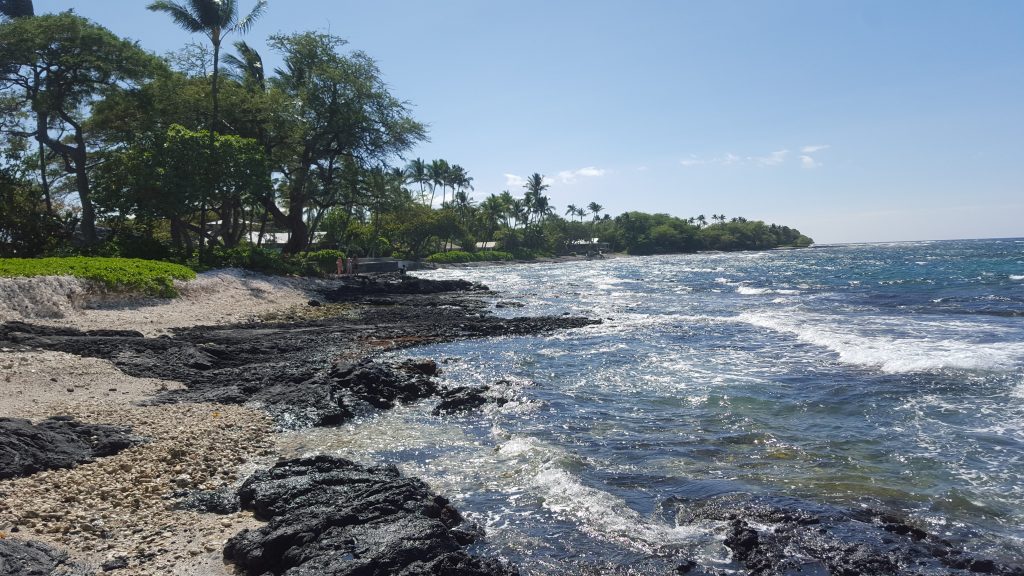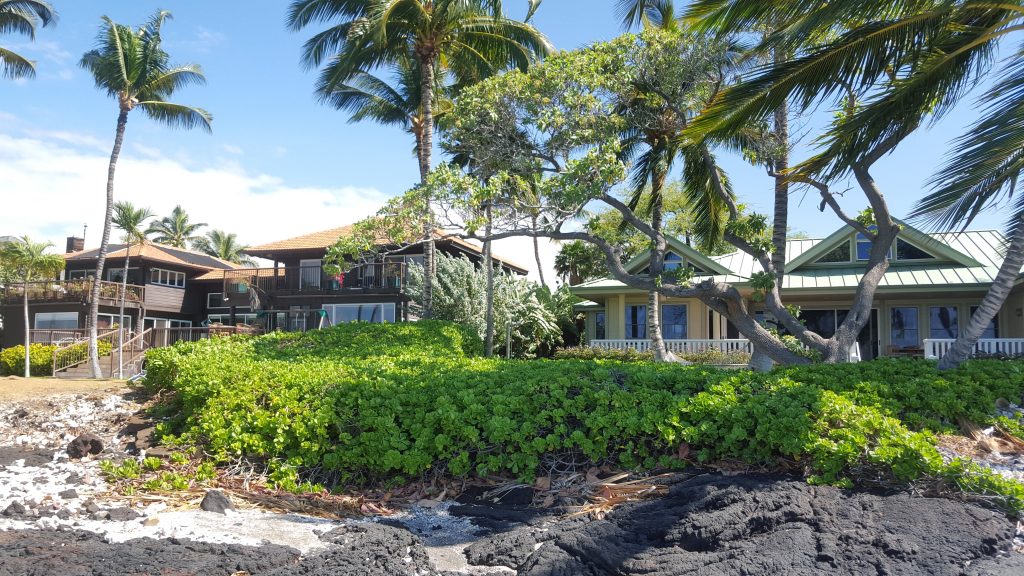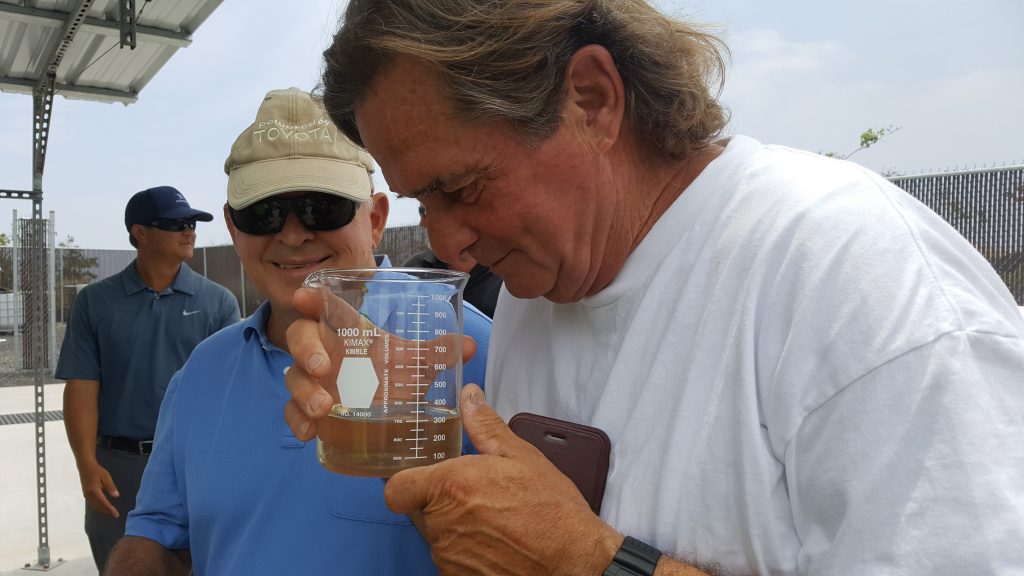Detecting and Addressing Sewage Pollution
Location
Puakō, Hawaiʻi Island
The challenge
A study published in August 2020 found a 45% decline in biomass of important fish species in West Hawaiʻi’s coral reefs over a 10-year period. Reefs in the South Kohala area are home to culturally significant species and provide economic benefits through recreational and commercial fishing. The reefs located along the Puakō coast of South Kohala are known to be some of the most intact and ecologically important reefs in the State of Hawaiʻi.
Puakō is one of many sites on Hawaiʻi Island showing signs of deteriorating reef health, including growth abnormalities, discoloration, and algal overgrowth. Experts are seriously concerned about the reef at Puako due to loss of fish biomass, decrease in coral cover, and increase in macroalgal cover.
At Puakō, sewage pollution is the biggest contributor to declining fish biomass, followed by spearfishing, collection for the aquarium trade, and lay net fishing. Sewage contains bacteria, nutrients, pharmaceuticals, and other chemicals. It has long been suspected to contribute to coral reef deterioration, coral disease, algae blooms, bleaching, and numerous human health concerns.

The rocky Puakō shoreline bordered by homes. Photo © Erica Perez/CORAL
Actions taken
Investigation of Sewage Impacts and Sources
In 2013, evidence from a Cornell study showing that sewage pollution is impairing coral reef health was presented to the Puakō Community. Subsequently, a study by The Nature Conservancy (TNC) and the University of Hawaiʻi Hilo determined cesspools to be a significant source of the contamination.
To determine the origin and extent of the damage to the reef, researchers conducted water quality tests of stable nitrogen isotopes, bacterial indicators (Clostridium and Enterococcus), and total dissolved nutrients (nitrate, phosphate, and ammonia). Fluorescent dye was placed in residential onsite wastewater treatment systems (OWTS) including cesspools, septic tanks, and aerobic treatment units (ATUs) in Puakō to determine the source(s) of pollution. The dye reached the shoreline quickly, ranging from less than 5 hours to up to ten days, suggesting noteworthy flow from toilets to reefs.
OWTS release effluent into the ground and contribute to non-point source pollution. Puakō’s porous volcanic rock, high groundwater, and proximity to the coast allows sewage to seep directly into the ocean with minimal retention in soils and uptake by plants. In addition, small lot sizes in Puakō are unable to accommodate adequately-sized drain fields, hindering the functionality of many OWTS treatment systems.

The proximity of homes to the shoreline poses challenges for onsite wastewater treatment for the Puakō community. Photo © Erica Perez/CORAL
Implementing a Solution
In response to the community’s request for assistance in developing a solution, this project aimed to assist navigation of the complex social, regulatory, mechanical, planning, and financial hurdles to reducing or eliminating sewage pollution. The project focused on the 2.5 mile stretch of volcanic shoreline in Puakō, where 180 homes currently use a mix of cesspools, septic systems, and ATUs. The Coral Reef Alliance (CORAL) established an Advisory Committee including representatives from the community, researchers, and experts to advise on next steps.
The following obstacles posed initial challenges to finding solutions:
- Lack of data to identify the source(s) of pollution and location(s) impacted along the shoreline.
- Need to identify ownership, operation, and maintenance strategies for implementation of sewage treatment.
- Need for consideration of project implementation under various financial and ownership frameworks.
- Potential urban sprawl leading to unwanted growth and increased pollution in the region. Limited government capacity to develop and operate new facilities and laws limiting the ability to leverage public/private partnerships.
- Fear of potential economic impact from tourists boycotting the area due to sewage.
Actions taken to generate solutions include:
- 2013 research from Cornell University confirmed the negative impact of sewage on coral health, sparking community concern.
- Researchers from the University of Hawaiʻi and The Nature Conservancy unequivocally linked sewage from OWTS in the community to poor water quality. Poor water quality hotspots were linked to higher incidences of coral disease.
- Extensive community engagement was conducted to educate the community about the problem, learn about community concerns and build consensus.
- A feasibility study was conducted leading to a Preliminary Engineering Report. The report recommended that the best solution was to decrease the number of OWTS in through development of a sewage system, treat wastewater to the highest possible standard, and dispose of the treated effluent farther away from the shoreline to avoid nutrient pollution. The geology and development of the area made other onsite sewage management options less feasible.
- In 2015, the community approved the idea to build a wastewater treatment facility to handle the community’s waste and reuse freshwater.
- In 2016, an assessment was conducted to determine how to implement a wastewater treatment plant and what it would cost, considering a variety of ownership and operation models as well as financing options for each. The capital and development costs of either a private community-owned or county-owned facility were estimated to be about $14.5 million, with different financing strategies for each option.
- In 2017, Act 125 was passed, mandating the replacement of all cesspools by 2050, and supporting the community’s efforts to improve sewage management.
- In 2018, in a report to the legislature, 14 communities across the state, including Puakō, were identified and prioritized for cesspool removal. The report suggested that Puakō contributed about 600,000 gallons of untreated sewage to the environment daily.
- In 2018, the Hawaiʻi State Legislature passed Act 132 which organized a cesspool conversion working group to develop an implementation plan for statewide conversion by 2050. Puakō is a potential demonstration site.
- In 2018, Hawaiʻi County agreed to develop the Puakō wastewater treatment project and CORAL began to work closely with the government to help secure funding for implementation.
- In 2019, the state appropriated $1.5 million in Capital Improvement Project (CIP) funds for Hawaiʻi County to conduct a planning and design study for Puakō’s sewer system to transition community members off of outdated cesspools. In the same year, Senator Inouye and Representative Tarnas both prioritized seeking an additional $15million CIP for construction funds in the 2020 Legislative Session. Note: due to COVID-19 and the postponement of the legislative session, these bills will need to be resubmitted in the 2021 session.
- The next steps include Hawaiʻi County conducting a planning and design study which will help determine affordability for the community and the county.

A community visit to a wastewater treatment plant to demonstrate new treatment technologies to improve nutrient removal and recover freshwater for reuse. Photo © Erica Perez/CORAL
How successful has it been?
After years of research and facilitation, the community and government agreed on a solution that will drastically reduce coastal sewage pollution over a 4-year timeline.
Lessons learned and recommendations
- Peer-reviewed literature demonstrating the sources and impact of sewage pollution was crucial for gaining stakeholder support.
- A key message is important for continued community engagement. Although expensive and time-consuming, the alternative is further deteriorating reef health resulting in major economic losses and human health concerns.
- A key message for government support was: “This is an economic as well as an environmental problem.”
- The community has a diverse financial demographic making the project’s cost and creative financing critical discussion points.
- While there are many emerging technologies for sewage treatment, few are permitted at the national or state level. Communicating this viability barrier was important for getting support for feasible solutions.
- Holding meetings, raising awareness, and communicating with community members and homeowners about concerns and ideas is time-consuming yet critical to success.
- Having a designated leader (organization or individual) is crucial for maintaining momentum and cultivating partnerships.
- A knowledgeable and trusted advisory committee, as well as a transparent decision-making process, is vital for building trust and support.
- Funder relationships are important so that organizations can make the best decisions with the information given and adapt to complexities of a project.
- The timing of these projects is difficult to predict making long-term funding necessary.

Local homeowners and Community Association members study treated freshwater. Photo © Erica Perez/CORAL
Funding summary
The state has allocated $1,5 million to Hawaiʻi County for planning and design over the next two years with a 20% match from the county.
Lead Organization
Coral Reef Alliance
Partners
Aqua Engineering
Hawaiʻi County- Mayors Office and Department of Environmental Management
Webb Municipal Finance
Puakō Advisory Committee (with reps from University of Hawaiʻi Hilo; Puakō Community Association, Hawaiʻi Rural Water Association; The Nature Conservancy; AECOM)
South Kohala Coastal Partnership
Resources
Clean Water for Reefs Puakō
Puakō Project Timeline
What’s in our Water?
Working Together for Clean Water


